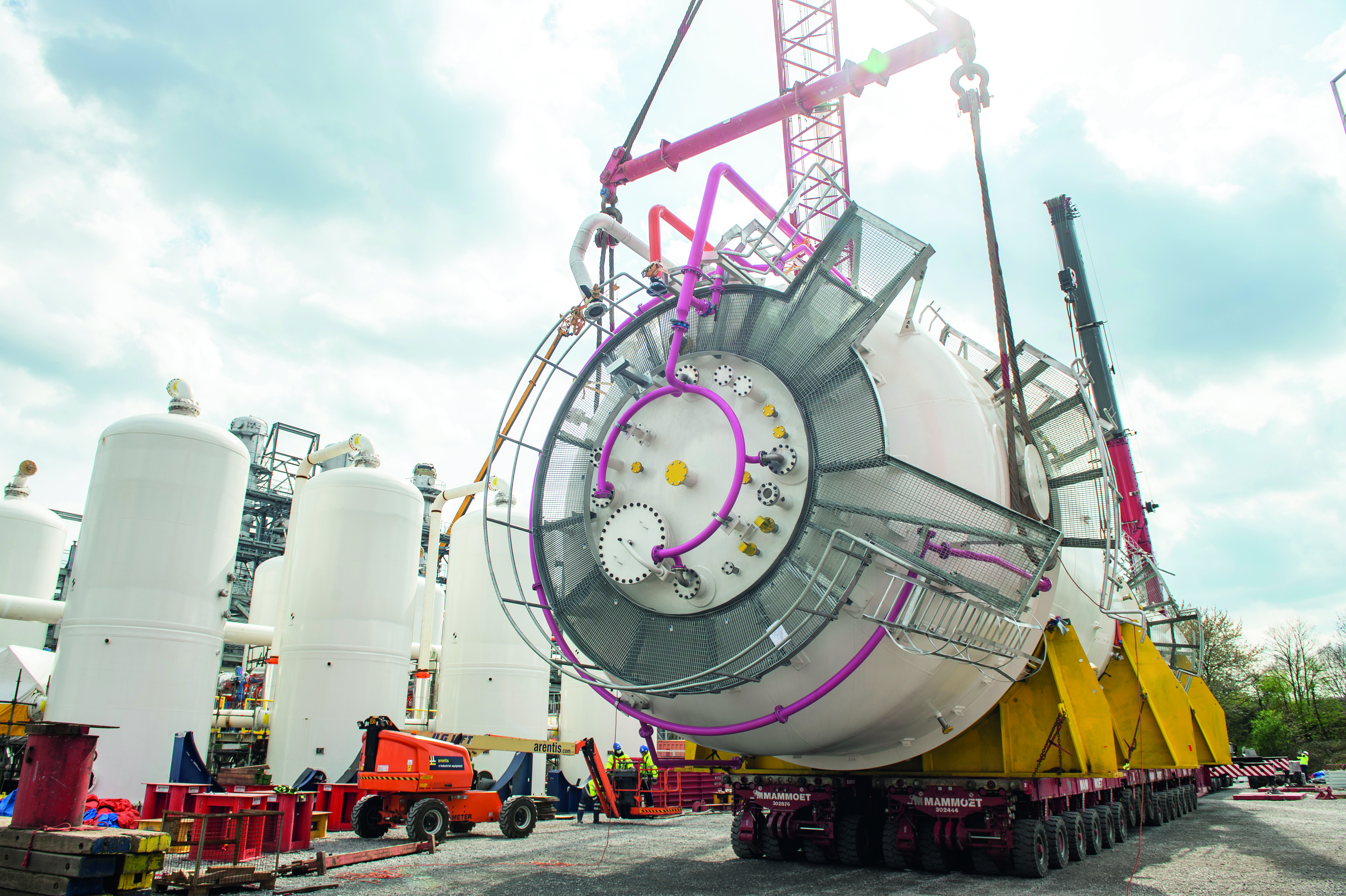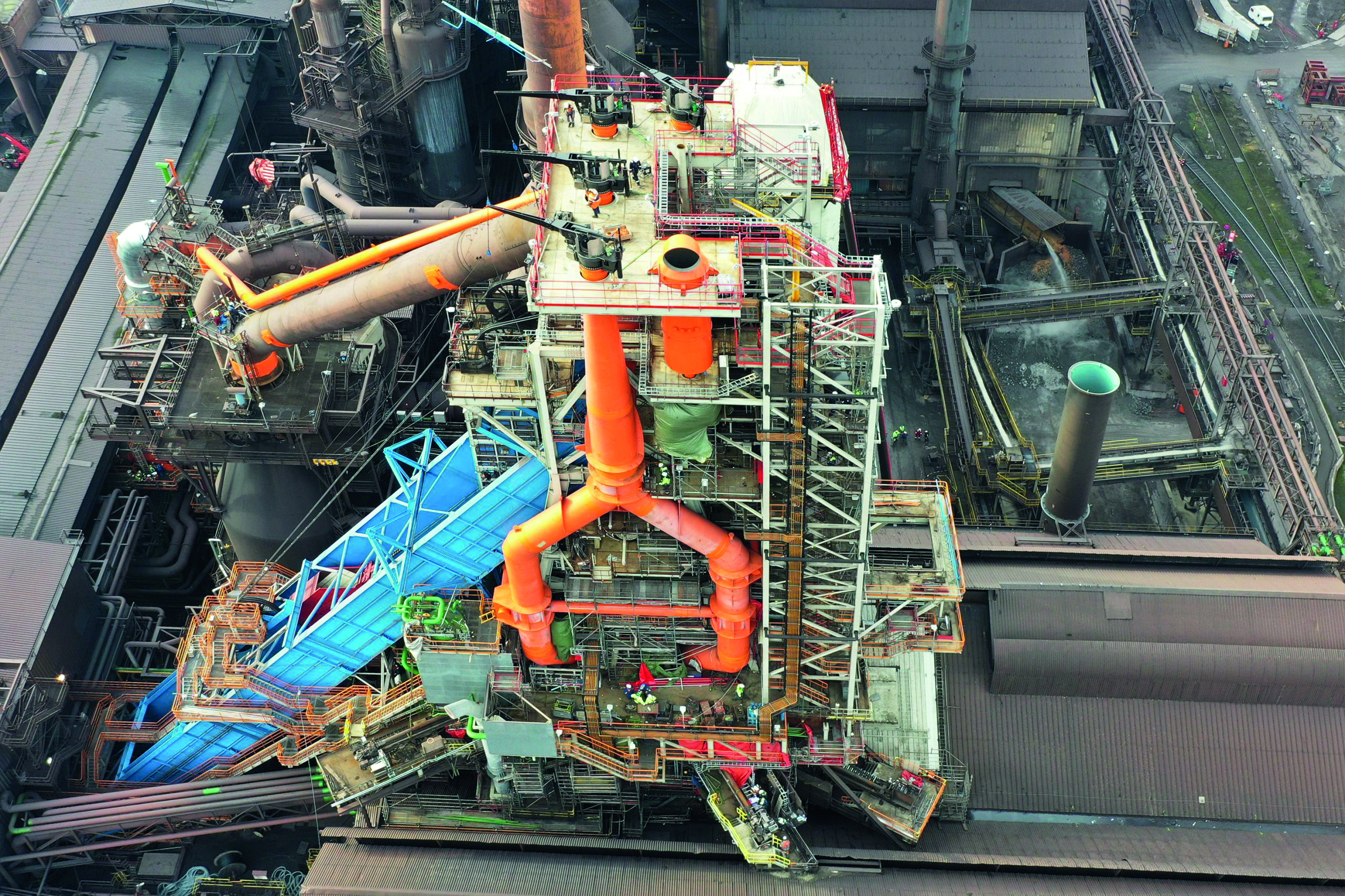With the total make-over of its blast furnace B, ArcelorMittal Belgium has reached a new milestone in its innovation, sustainability, and circularity drive. The largest investment in the history of the Ghent steel plant is part of a much larger approach to achieve the ambitious climate objectives the steel manufacturer is aiming at, explains Geert Van Poelvoorde, the new CEO of ArcelorMittal Europe. Clients can start benefiting from these efforts to limit their own ecological footprint by buying steel with a green certificate.

The four bioreactors for the pioneeringThe four bioreactors for the pioneeringSteelanol installation were delivered inMarch 2021. Photo courtesy of ArcelorMittal.
No item ranks higher than decarbonisation on ArcelorMittal’s agenda for the coming years, Mr Van Poelvoorde stresses. “We aim at reducing our CO2 emissions by 30% by 2030 when compared with 2018, and to be climate neutral by 2050. Due to the processes involved in steel making, the challenge for our industry, which emits about 7% of all CO2 worldwide, is gigantic. Achieving these goals will require massive R&D efforts and investments.”
Two routes on the map
In its Climate Action Report published last summer, ArcelorMittal Europe outlines the two routes to advance in the right direction. The ‘smart carbon’ route is the way to go to reduce the input of coal and the output of carbon in blast furnaces by using residual materials (like waste wood, plastics, and gasses) as fuels and turning furnace gasses into building blocks to produce basic chemicals that can be reused. The other route consists of using the DRI technology (direct reduced iron) in combination with an electric arc furnace (EAF). “DRI takes away 70% of the carbon. But at the present time, it runs on natural gas and is thus only commercially viable where natural gas is readily available at an affordable price. This is not the case in Europe. And building a DRI requires an investment of EUR 1 to 1.5 billion, while the steel produced would become completely uncompetitive due to the high gas prices.”
Both routes could make use of hydrogen to cut back carbon emissions to almost zero. “The problem is that hydrogen is not yet available in the needed quantities, nor at the right price. Furthermore, we still lack the very large volumes of renewable energies to produce green hydrogen and there is not yet a hydrogen grid comparable to what we have for gas or electricity. A lot of work is being done to make all of this happen, but it will take many more years to get there.”
It does not mean nothing can be done in the meantime, the CEO emphasises. “We are exploring all possible options and our plant in Ghent is one of the front-runners in this field, with its very strong reputation in R&D, productivity, and innovation. Each tonne of steel produced by ArcelorMittal Belgium is already 20% more environment-friendly than steel produced elsewhere in Europe, and 33% more than non-European steel. Compared with 1990, we emit 23% less per tonne today. A lot of projects leading to a further reduction in our emissions are underway (see box). To become carbon-neutral, we will need to shift into a higher gear.”
Green steel certificate
But clients do not have to wait any longer to take advantage of ArcelorMittal’s improved ecological performances. “For many of them, steel is an important source of ‘Scope 3’ emissions coming from their suppliers. We wanted to pass on our CO2 reductions. Each tonne of steel represents about 2t of CO2. So if we lower our emissions by 100,000t, that can be considered as the equivalent of 50,000t of carbon-neutral steel. We can then deliver 50,000t of steel with a green certificate that the buyers of our steel can use to limit their Scope 3 emissions. In accordance with the Greenhouse Gas Protocol, the certificate – which is based on an independent audit and which we sell under the XCarb trademark – reflects the gains we have made in lowering our emissions within our whole group and which this system allows us to pass on to our customers.” “For the steel industry, this is a first. But you can compare it with the green electricity you buy: your provider will have to be able to present renewable energy certificates to guarantee that the volume of green energy he sold is covered by a corresponding production in renewable energy. It does not mean the electricity you get out of your power plug can be directly traced to a windmill on the North Sea at the other end of the grid. We apply the same principle. But our ambition is, and should be, to produce net zero-carbon steel.”our ambition is, and should be, to produce net zero-carbon steel.”The blast furnace B underwent a totalmake-over and is now one of theworld’s most modern and efficient.INDUSTRYPortNews I 37The first 30,000t of steel with a green steel certificate wereproduced last year. That volume will rise to 120,000t this year,before climbing to 600,000t in 2022. Still a far cry from thevolumes needed to reach the 30% target in 2030, but that willrequire DRI/EAF installations, he adds. “If you build a DRI with acapacity of 2t million, this means 2.8t million of CO2 you can avoid.That is where the big leap forward will have to come from.”
New furnace
“We are more than willing to take up our responsibility and do our part in decarbonising our industry. We are front-runners in this field, with 1,400 researchers in Europe”, Mr Van Poelvoorde states. “But we need Europe and the Member States to take the right decisions with regard to the Emission Trading System (ETS), with its price for carbon and its free carbon allowances; to regulate the access to the European market for steel that does not bear the same carbon costs and constraints through a Carbon Border Adjustment that creates a level playing field; and to put into place the funding mechanisms that help us make the transition to low and then to net zero carbon steel happen. If not, we will get carbon leakage, with a big part of the steel industry disappearing in Europe. That would have a dramatic impact on downstream activities and jobs. Europe has everything to gain from taking the lead in decarbonising the steel industry. Setting the example will preserve our economy, give us a technological advantage, and force others to follow.”The message also applies to the future of the steel plant in NorthSea Port, he makes clear. “Our blast furnace A will reach the end of its current lifespan by 2025. Relining it like we did with furnace B is not impossible, but is not a future proof solution. In today’s context, replacing it with a DRI is a better option. It is the one we are exploring in Germany and France in similar situations. We have introduced demands for European aid within the framework of the Hydrogen IPCEI (Important Project of Common European Interest) and both countries are prepared to lend us a hand. We are not that far yet in Belgium. A decision needs to be taken by 2023, which still leaves us a bit of time. But if we want to keep production capacity in Ghent at 5.5t million, we will also need the support of the federal and regional authorities. We cannot do it alone.”

The blast furnace B underwent a total make-over and is now one of the world’s most modern and efficient. Photo courtesy of ArcelorMittal.
Exploring all avenues
The list of investments made by ArcelorMittal Ghent to optimiseits production process, improve efficiency, reduce emissions,and increase circularity is getting longer by the day. The plant is spending vast amounts of money in state-of-the-art technologyon its way to a greener future, with reduced and low-carbon products as a stepping stone to zero-carbon steel.
- The new blast furnace B, now one of the world’s mostmodern and efficient in terms of productivity, automation, andemissions, costs EUR 195 million. It was inaugurated in earlyMarch.
- The Torero installation allowing to use pre-treated waste wood as a fuel to replace coal requires an investment of EUR 50 million. When commissioned in 2022, it will reduceCO2 emissions by 225,000t per year.
- The Steelanol unit to turn CO into bio-ethanol bears a pricetag of EUR 165 million and brings down CO2 emissions by 135,000t a year. It will be up and running next year.
- The Calisto project (CArbon dioxide LIquefaction for STOrage) is looking into the possibility to liquefy and store CO2.
- The plant participates in the North-C-Methanol and North-CCU-Hub projects for the production of green methanol andthe reuse of CO2.
- New windmills and solar panels add to the renewable energy capacity, which already represents 50MW at peak.
- The recycling of scrap as raw material – “the easiest way todecarbonise steel” – has been expanded to about 1t million a year. But scrap is in short supply and ‘virgin iron’ remains needed for the high-quality grades of steel produced in Ghent.
ArcelorMittal Belgium is also a very active partner within the cross-border Smart Delta Resources platform. Within this framework it pursues circular synergies with partners within NorthSea Port like Dow Terneuzen in projects such as Carbon2Value and Steel2Chemicals. A hydrogen pipeline connecting the two major industrial players in the sea canal area is under examination.The use of the waterway and rail as alternatives to road haulage to make the logistics chain more sustainable has been reinforced over the past years. On a more local level, ArcelorMittal Ghent is developing a heat grid with surrounding communities. The employees contribute to the company’s greening by commuting more often by electrical car or bike. One hundred charging stations (offering 200 charging points) will be installed next year.


